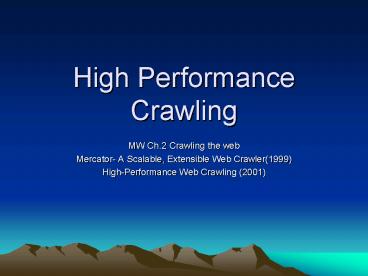High Performance Crawling - PowerPoint PPT Presentation
1 / 21
Title:
High Performance Crawling
Description:
Mercator- A Scalable, Extensible Web Crawler(1999) High-Performance Web Crawling (2001) ... 4 byte fingerprint ? Anatomy of a large-scale crawler. The End. ... – PowerPoint PPT presentation
Number of Views:53
Avg rating:3.0/5.0
Title: High Performance Crawling
1
High Performance Crawling
- MW Ch.2 Crawling the web
- Mercator- A Scalable, Extensible Web
Crawler(1999) - High-Performance Web Crawling (2001)
2
Why Crawling?
- Information gathering
- Info processing and service
- Info mining
- Info archiving
- Information discovering
- Web size? Statistics? Evolution?
- Goal
- Generalized web crawling
- Fetech all the pages of the web
3
Just follow the links, Right?
4
Basic Crawling Algorithm
- Simple-Crawler(S0,D,E)
- Q?S0
- While Q??
- Do u? dequeue(Q)
- D(u)?fetech(u)
- Store(D,(d(u),u))
- L?parse(d(u))
- For each v in L
- Do store(E,(u,v))
- if (v?D ? v?Q)
- Then enqueue(Q,v)
5
Lets think about it a little longer
- The Web is huge
- 1 billion pages / per month?385pages/sec
- Morn than connecting to host in fetch()
- Dns and tcp connection/transfer overheads
- No enough memory to hold all data structure
- Is url or pages seen? ?time-space trade-off
- The real world is not perfect
- url/html syntax error , server traps
- Server complains, legal issues
6
High-performance Crawler need
- Scalable
- Parallel , distributed
- Fast
- Bottleneck? Network utilization
- Polite
- DoS, robot.txt
- Robust
- Traps, errors, crash recovery
- Continuous
- Batch or incremental
7
DNS resolver
- Fetch ? http//ibook.ics.uci.edu/
- Problem synchronized and very slow!
- Solution A customized DNS component with..
8
Custom client for dns resolution
- Tailored for concurrent handling of multiple
outstanding requests - Allows issuing of many resolution requests
together - polling at a later time for completion of
individual requests - Facilitates load distribution among many DNS
servers.
9
Caching server
- With a large cache, persistent across DNS
restarts - Residing largely in memory if possible.
10
Prefetching client
- Steps
- Parse a page that has just been fetched
- extract host names from HREF targets
- Make DNS resolution requests to the caching
server - Usually implemented using UDP
- User Datagram Protocol
- connectionless, packet-based communication
protocol - does not guarantee packet delivery
- Does not wait for resolution to be completed.
11
Page fetching
- Problem network connection and transfer
overheads - Solutions Multiple concurrent fetches
- Managing multiple concurrent connections
- A single download may take several seconds
- Open many socket connections to different HTTP
servers simultaneously - Multi-CPU machines not useful
- crawling performance limited by network and disk
- Two approaches
- using multi-threading
- using non-blocking sockets with event handlers
12
Multi-threading
- logical threads
- physical thread of control provided by the
operating system (E.g. pthreads) OR - concurrent processes
- fixed number of threads allocated in advance
- programming paradigm
- create a client socket
- connect the socket to the HTTP service on a
server - Send the HTTP request header
- read the socket (recv) until
- no more characters are available
- close the socket.
- use blocking system calls
13
Multi-threading Problems
- performance penalty
- mutual exclusion
- concurrent access to data structures
- slow disk seeks.
- great deal of interleaved, random input-output on
disk - Due to concurrent modification of document
repository by multiple threads
14
Asynchronous I/O
- non-blocking sockets
- connect, send or recv call returns immediately
without waiting for the network operation to
complete. - poll the status of the network operation
separately - select system call
- lets application suspend until more data can be
read from or written to the socket - timing out after a pre-specified deadline
- Monitor polls several sockets at the same time
- More efficient memory management
- code that completes processing not interrupted by
other completions - No need for locks and semaphores on the pool
- only append complete pages to the log
15
More
- How many connections are enough?
- Probability of cpu busy
- Network bandwidth utilization
- Quantity of context switch overheads?
- ms?
- Difference between multithread and AIO beside
context switch?
16
IsUrlVisited?
- Validate Url before Enqueue(Q,v) to avoid
download pages more than once. - Issue time and space
- Fingerprints of URL
- Hold the structure in memory?
- Physical limitations of disk speed can reduce
performance to 75 downloads per second.
17
Cache
- Exploiting spatio-temporal locality of access
- Popular url/host
- Locality inside host
- Implementation
- Two-level hash function.
- most significant bits (say, 24) derived by
hashing the host name plus port - lower order bits (say, 40) derived by hashing the
path - concatenated bits use d as a key in a B-tree
18
Mecrator implementation
19
More
- Probability Set test algorithm
- Bloom filter
- Short fingerprint with collisions?
- 4 byte fingerprint ?
- ???
20
Anatomy of a large-scale crawler
21
The End.

